How one woman and a tiny ocean refuge helped sea otters escape extinction
From "extinct" to "maximum carrying capacity," a staunch mayor and her 11-acre refuge for abalone changed the trajectory of a species that once dwindled to 50 individuals.

One hundred years ago, California’s Monterey Bay was an ecological mess. Canneries were dumping 100,000 pounds of fish guts into the water every day, suffocating sea life and sending a stench up and down the central California coast. The sardine fishery peaked in 1937 at an annual yield of 700,000 metric tons. Over the next two decades, the fishery would slowly collapse.
One hundred years ago, sea otters were “extinct” in California. Giant kelp forests had disappeared in Monterey Bay. Humpback, blue and grey whales had been hunted to near extinction. With no fish to eat, seals and dolphins left. Diving seabirds like cormorants and petrels chose other hunting grounds. Shellfish like abalone were overharvested and disappeared from tidal zones.
Now, 3,000 southern sea otters call California home. Monterey Bay teems with life. Sardines have returned. Eight species of whales, including orca, pass through the bay. Diving seabirds, harbor seals and sea lions zip through underwater giant kelp forests. The bay is a worldwide destination for viewing and studying ocean life.
All thanks to a woman named Julia Platt and a small marine life refuge she established in 1931 that lured sea otters to the bay.
Yes, a few furry sea otters are powerful enough to bring back whales.
To know why, we must understand these four facts:
Purple sea urchins and abalone are voracious grazers of kelp. Left unchecked, urchins will mow down and eliminate all kelp, leaving urchin “barrens.”
Sea otters love to eat urchins and abalone. One sea otter can eat 25 pounds of shellfish per day.
Where sea otters thrive, kelp forests flourish.
Kelp forests are the fish nurseries of the sea, and provide protective habitat for thousands of animals, big and small, including forage fish such as anchovies and sardines that whales like humpbacks love.
The Death & Life of Monterey Bay (2011, Island Press) by Steven R. Palumbi1 and Carolyn Sotka recounts the journey of the southern sea otter, its benefits to the Monterey Bay ecosystem, and the woman who was pivotal to its survival.
A cast of unique characters turns the tide
How did otters make such a comeback? How did the bay turn full circle from utter devastation to marine haven?
Rewind again 100 years. Enter John Steinbeck’s friend Ed Ricketts, who was the inspiration for the character Doc in “Cannery Row.”
Ricketts, a marine biologist,2 was harvesting and selling ocean critters like starfish, urchins and sea slugs to classrooms across the country. He was able to do so because another marine biologist, Julia Platt, had taken a hatchet to a private fence that was blocking shoreline access. Platt’s ocean advocacy got her elected mayor of the small coastal town of Pacific Grove.
Platt tore down the fence to open the beach to the public, but she didn’t predict Ricketts would begin collecting slugs right in front of her house. She didn’t like that one bit.
Seeing the havoc that was suffocating the bay and hoping to preserve some safe spawning grounds for marine invertebrates, Platt grew determined to set aside 11 acres of seafloor that no one could touch.3
In 1931, Pacific Grove established the Hopkins Marine Life Refuge. Perched at the southern tip of Monterey Bay, the refuge prohibited harvesting invertebrates: nudibranchs, shellfish, abalone and urchins.
Little did Platt know, but this move would prove critical for a species she and others thought was extinct: the southern sea otter. Platt passed away in 1935, long before she could experience the magnitude of what she’d created. Her actions brought about an ecological cascade that persists to this day.

Establishing the refuge was no easy feat. The State of California alone maintains jurisdiction over the coastline. Undeterred, Platt petitioned the state to grant an exception. In 1931, the California Legislature agreed to allow Pacific Grove to police the shoreline, the only time in history it’s ever yielded that jurisdiction to a town.
Platt thought that if she could preserve one small piece of ocean as a seedbank, it could continuously regenerate the overexploited areas around it.
“Tiny larvae may swim or be carried by currents to all points along the shore …” (Palumbi and Sotka, page 84).
Abalone soon grew abundantly at the refuge. Mussels crowded up the shore. Urchins filled the seabed.
Then, in 1938, sightseers on boats spotted sea otters at Big Sur. At that time, no one had seen a sea otter in California in nearly 100 years. Those initial sightings counted as few as 50 animals hiding 30 miles south of Monterey Bay, in the coves below the steepest cliffs of California’s coastline.
It took three decades, but because sea otters are voracious abalone hunters, they found Platt’s Hopkins Marine Life Refuge.
“Even the earliest otter watchers realized that these quick and charming animals moved like a plague of locusts across the landscape, depleting resources in an area and then moving on. So it was no surprise that the first otters to round Point Pinos and enter Monterey Bay were a few young males, who turned the corner of California history in 1962.” (Palumbi and Sotka, page 128)
By April 1963, a raft of 75 sea otters had taken up residence in the refuge.
The magic happened when giant kelp forests regrew. The otters brought the ecosystem into balance by eating abalone and urchins, which had been consuming kelp. Kelp creates 100-foot-tall curtains that protect seals, fish, octopus and otters from sharks and other predators.
“The number of living creatures of all Orders, whose existence intimately depends on the kelp, is wonderful.” — Charles Darwin 18451
A keystone species and “top predator”
An ecological cascade followed. Turns out, sea otters are a keystone species. Without them, their ecosystem collapses. With them, marine ecosystems boom. By eating urchin and abalone, otters ensure their own habitat, giant kelp forests, thrive. Tidal marshes, too, benefit from the services of sea otters: They prevent erosion by controlling crabs that dig burrows and eat grass roots.
Sixty years after those first otters ventured back, Monterey Bay is filled to the brim with kelp forests and sea otters. Now, a huge marine sanctuary encompasses the bay and stretches 276 miles up and down the central California coast. It’s home to hundreds of species, including humpback, sperm, grey and blue whales, dolphins, harbor and elephant seals, seabass, and anchovies. Seabirds include albatross, storm-petrels, brown pelicans, loons, cormorants, scoters, grebes and gulls.
“The reconstruction of an ecosystem, link by ecological link, is seldom seen in the modern environmental narrative,” Palumbi and Sotka write. “Julia’s protected areas may have been one of the catalysts for such a construction cascade in Monterey Bay, although many other elements also had to fall into place.” (page 137)
Zoos and aquariums across the country participate in sea otter conservation. The Monterey Bay Aquarium4 runs a robust sea otter rehabilitation program. Rough winter storms sometimes separate baby sea otters from their mothers. When beachgoers find an abandoned pup on shore, the aquarium staff takes the pup out on the bay, where their mothers hear their cries and will often snatch them back up. If not, the aquarium brings the pups to their facility, where surrogate mothers teach them how to dive for and crack open shellfish.
Once ready, these otters are released into the calm waters of Elkhorn Slough (pronounced “slew”) 20 miles north of the original marine refuge. The slough is California’s largest estuary and spans 45,000 acres, reaching seven miles inland. About 1,700 acres of agricultural lands abutting Elkhorn Slough were converted to a state wildlife area and ecological reserve where motorboats and docking are prohibited. The slough is home to 120 otters and it’s reached “maximum sea otter carrying capacity,” according to the aquarium.5

Climate change, sharks and disease
Otters now face two main threats: sharks and toxoplasmosis, a parasite carried by domestic cats, mountain lions and feral hogs. Toxoplasmosis washes into the ocean through feces. It doesn’t harm carrier animals like cats, but has proven lethal to sea otters.
In addition, sea otters haven’t been able to spread north of Monterey Bay further into their historic range because of sharks roaming near the elephant seal6 colony at Año Nuevo State Park. Sharks don’t consider otters food, but they kill them anyway.
Finally, these ecosystems are not immune to the ravages of climate change. Kelp forests died off along much of California’s central and north coast due to a “blob” of warm water that persisted for several years beginning in 2014. The blob didn’t kill the kelp. But it caused a wasting disease that devastated sunflower sea stars, purple urchins’ only other predator besides otters.7 Millions of urchins have created vast “urchin barrens” devoid of kelp.
Sea otters could help. Conservationists have long discussed transplanting otters further north, but so far, none have succeeded at gaining public approval. Fisher groups adamantly oppose the idea, not wanting to share dwindling crab or abalone stocks with otters.
Urchin barrens also now spot Monterey Bay, but a 2021 study showed sea otters protected healthy kelp forest by eating more purple urchins when their numbers skyrocketed.8
By doing this, the sea otters are helping to maintain those patches of healthy kelp forest, which are now crucially important for the persistence of giant kelp along the coast. Spores produced from those remaining patches could eventually reseed the barren areas and restore the kelp beds.
Also, listen to the cheers as these divers spot a sunflower sea star, the first in many years, in Northern California:
A little refuge with big impact
The International Fur Seal Treaty prohibited hunting sea otters in 1911, long after they were considered extinct in California. Sardine fishing was banned in Monterey Bay in 1967 and the last cannery shut in 1973. The U.S. Endangered Species Act of 1973 protects current sea otter habitat from degradation.
But none of these policies proved critical to the sea otters who hid out under the cliffs of Big Sur for a century. The one thing they needed was abalone and they found it at Platt’s small refuge. Now, they roam as far south as Santa Barbara and will continue to safeguard kelp forests for generations.
What would have happened if Julia Platt hadn’t dug in her heels to protect a small slice of ocean?
It goes to show: One woman and one tiny refuge can make it or break it for a species.
“Even if no other bay will ever have exactly this story, the fact that a local shore has been driven to the depths of ecological ruin and has recovered—this shows that the pathway of recovery from ruin exists, and is a possibility for places that anyone else calls home.”
— The Death & Life of Monterey Bay (2011, Island Press)
This book is the inspiration for Earth Hope.
Quick facts:
Giant kelp can grow 18 inches per day.
Kelp forests sequester carbon.
Urchins and abalone mainly eat kelp.
One sea otter consumes 15-20 pounds of shellfish per day.
Before baby sea otters are buoyant enough to float on their own, their mothers wrap them in kelp to keep them afloat.
Sea otters, unlike other marine mammals, do not have blubber. They keep warm through their thick fur and constant movement, which requires calories.
All the fur on a cat’s body can fit into one square inch of sea otter fur.
The California sea otter, also known as the southern sea otter, is a subspecies that inhabits the central California coast. Historically, they inhabited Southern Oregon down to Baja California, Mexico. The southern sea otter is smaller than the northern sea otter, which roams the Pacific from Oregon to Washington, Alaska, the Aleutian Islands and west to Japan.
A group of sea otters is called a raft.
Further reading:
Discover Magazine: Why are sea urchins so destructive to kelp forests?
Monterey Bay Aquarium: The secret life of sea otters and A history of the Monterey Bay Aquarian Sea Otter Program
UC Davis: Sea otters killed by unusual parasite strain
Press Democrat: North Coast officials, scientists and stakeholders launch exploration of sea otters’ return
Hakai Magazine: Sea otters are walled in by hungry sharks
Mercury News: Deep diving sperm whales frequent Monterey Bay more than previously thought.
Anthropocene Magazine: The remarkable restoration of a degraded coastline brought on by returning sea otters
As the otter numbers grew, the dynamics within the salt marsh changed. Between 2008 and 2018, erosion of tidal creeks in the estuary fell by around 70% as otter numbers recovered from just 11 animals to nearly 120 following a population crash tied to an intense El Niño climate cycle.

AI “creature” headlines are dumbing down conservation and science stories
I first published a version of the above story using WordPress about a year ago. When I was ready to post it, a WordPress AI plugin suggested that I change “sea otter” to “creature.” Now, I can’t ignore creature headlines.
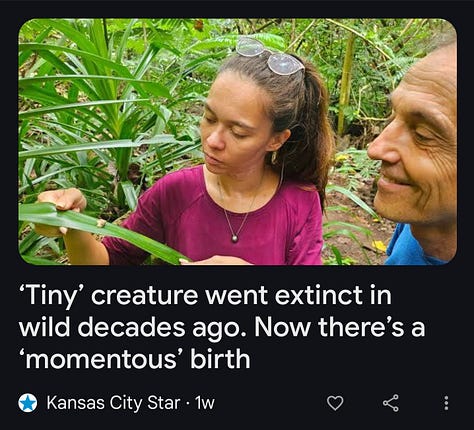




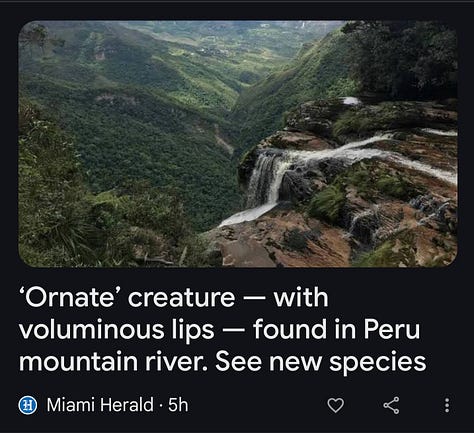
How about these human-written headlines. Better, no?
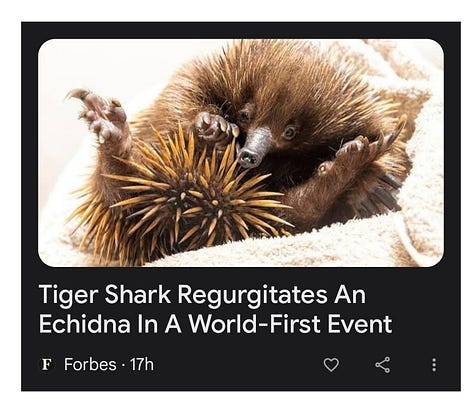


About Earth Hope:
Earth Hope is a solutions-based journalism project that highlights environmental success stories from around the globe, because hope is the foundation of progress. Consuming bad news is important, but we should also remind ourselves frequently that progress happens every day. Read more about this project and what inspired it.
About me:
I’m Amanda Royal, a former newspaper reporter who covered wildfires, invasive species, water quality, wildlife and other environmental topics in California and Nevada (while writing under my maiden name and byline Amanda Fehd). I also worked for an environmental advocacy group for five years.
Palumbi is a marine science professor at Stanford University.
Ricketts also did his fair share of advocacy for the bay. He pushed for reducing sardine harvest rates but was ignored. A separate marine refuge in the bay is named after him.
She appears to have held a personal vendetta against Ricketts. It’s not clear if his sea slug harvesting was the only thing that got to her.
The aquarium occupies a former cannery, which was the largest in the area.
Visit Elkhorn Slough in January or February and you’re sure to see mother otters with babies on their stomachs. In the slough, otters eat mudflat worms (fat inn keeper worms) that look like hot dogs.
Elephant seals are another species once thought extinct.
Further south in warmer waters, spiny lobster and California sheephead eat urchins, so kelp forests have survived.
Please read the article for complete understanding. Urchins in urchin barrens are starving and lack nutritious gonads/uni. Sea otters will not eat these. Urchins on the edges of healthy kelp forest contain uni, perhaps because they ate enough kelp. Transplanting otters to urchin barrens will not solve anything, but transplanting otters to areas where kelp still survives and otters have plenty of other food could be a strategy.


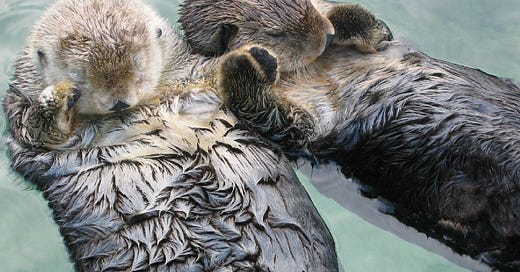




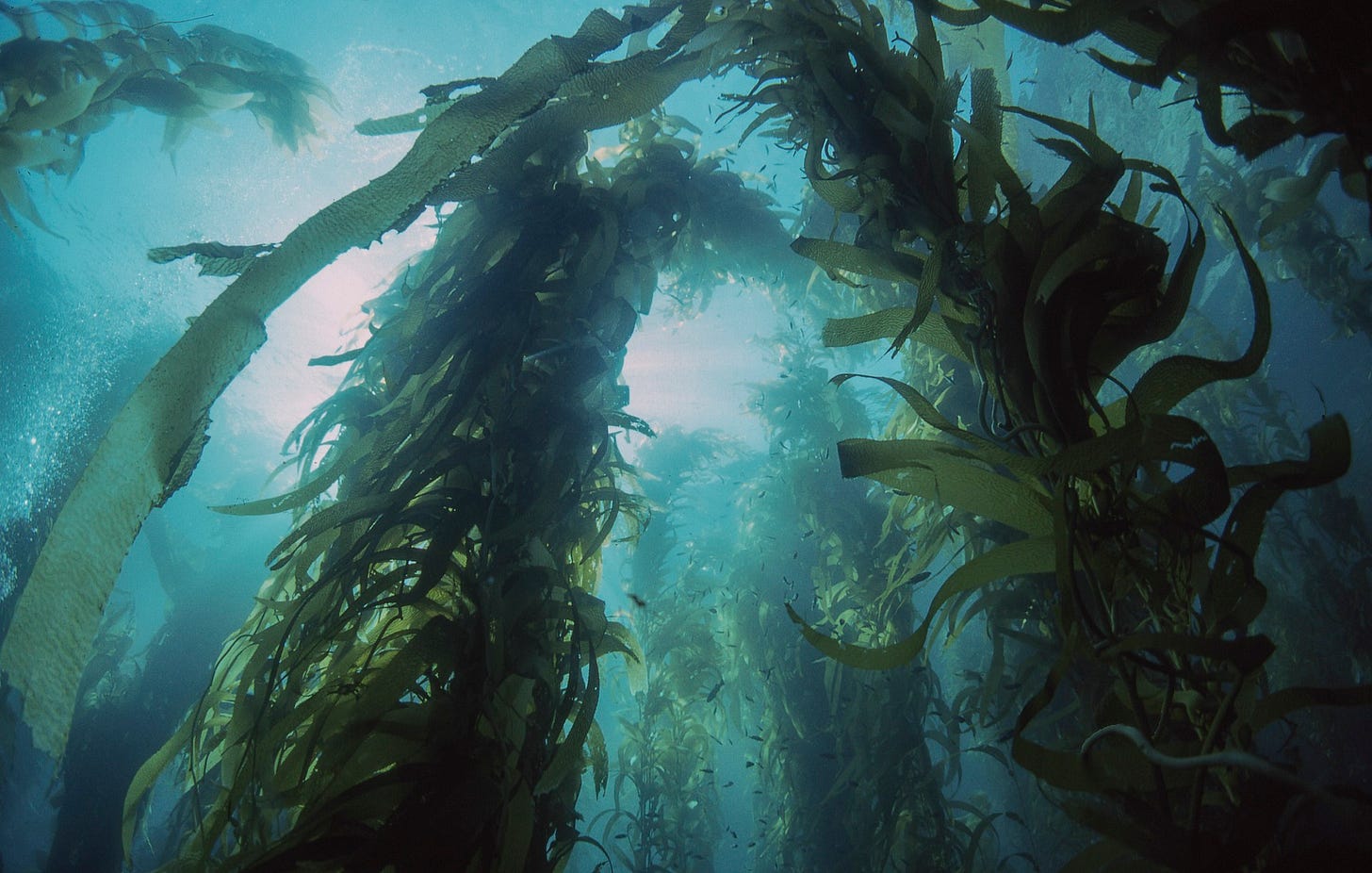

I was hungry after reading of the bounty that awaited those first returning sea otters at this sanctuary. Madam Platt's vision as a biologist was remarkable. By divining the need to seed the sanctuary for future life, she created one of the great teaching episodes of environmental history. Luckily she ran for mayor, so was able to deal with the environmental and political aspects of the situation. A remarkable tale.
Amanda, your research, photos and notes are inspiring. Keystone animals are the keys to maintaining ecosystems . Humans somehow don’t seem to fit. We are like a Vance and destroy ourselves. Make there is an undiscovered gene that is programmed in certain individuals to destroy and others to create.